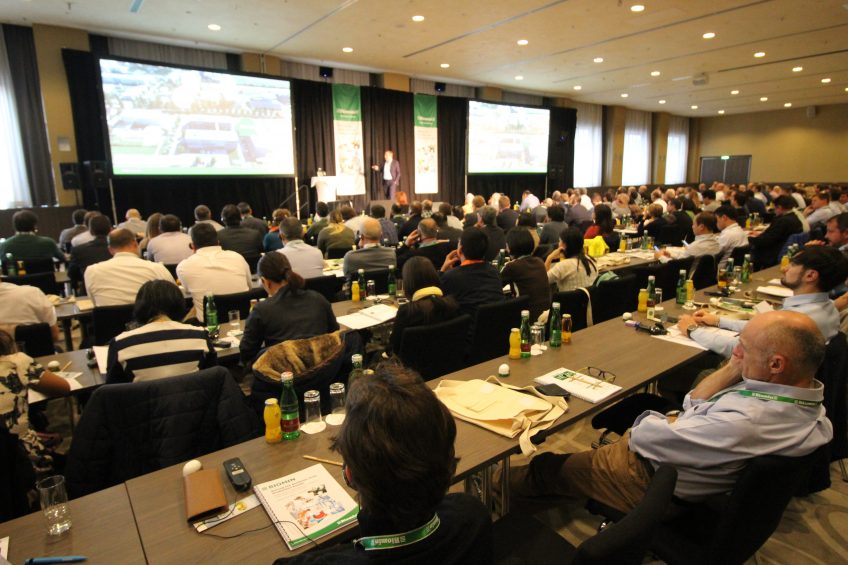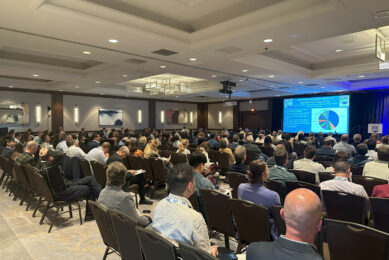Biomin widens antibiotics debate in swine production

The antibiotics debate is going beyond the discipline of providing the correct ingredients in swine diets – so much is clear for feed additives manufacturer Biomin. The company hosted an event to solve the antibiotic-free production puzzle and invited many non-nutrition speakers to jointly investigate approaches.
The event, held on November 21-23, drew approximately 250 visitors from at least 27 countries worldwide to Vienna, Austria.
As is known, Europe has taken a leading role worldwide in reducing the use of antibiotics, with the banning of antibiotics as growth promoters and several countries now being successful in further antibiotics reduction, predominantly by actively reducing preventive use. How do they do it, what obstacles do they overcome and which ideas from other disciplines within the pig business can be found – other than using feed additives?
Time to re-think how to do animal production
Dr Mark Beghian, owner of Italian company Unitec, specialises in biosecurity issues and had a clear message for his audience: if we want to substantially reduce antibiotic usage, it’s time to re-think how we do animal production.

He pointed out various reasons why:
- Climate change (which will lead to new disease pressure)
- Day-to-day farm management (e.g. in Italy farms can be located as close as 300 m from each other!)
- Sustainable development goals
- Mindset & cultural backstage: from every angle thinkable antibiotic reduction makes sense – for the environment, food safety, sustainability and animal welfare point of view
- Value assessment: biosecurity pays off in the long-run
Quite nicely, he closed off his presentation with a series of practical recommendations, e.g. that farmers disinfect using a good detergent; that pigs need clear water from clean nipples; footdips should never be optional; don’t create overcrowded pig pens; and always disinfect hands before touching the pigs.
Proper health management and antibiotics reduction
Veterinarian Ferdinand Entenfeller then mounted the stage with another practical story on do’s and don’ts when running a swine farm – health management is the key in his opinion. He presented a long list of management things that could receive attention in order to improve the general conditions for pigs – thus lowering the need for antibiotics as simply fewer pigs have health problems.

Below is just a few of the recommendations he gave:
- Ventilation/climate is important, especially in tropical regions, to keep temperatures for sows and pigs reasonable
- Choosing proper genetics – and not using unhealthy breeding stock – helps to generate healthy animals to start with
- Applying the right feeding regimes (more on that later)
- Synchronise oestrus with gilts and sows to ensure an easy insemination process
- A harmonious and regular production schedule
- Making sure piglets receive colostrum in time
- Using overpressure inside the pig barn to avoid pathogens coming in when doors are opened
- Filtering and disinfecting air that is being drawn in
Why vaccination can help reduce antibiotics
Well-known speaker Prof Paolo Martelli, Parma University, Italy, and also president of the European College for Porcine Health Management (ECPHM), said that antibiotics cannot be eliminated because we simply need to be able to treat sick animals. Nevertheless, he made his message crystal clear when he said: “Antibiotics cannot be an ‘umbrella’ protecting against lack of management, environment, biosecurity, welfare, etc.”

Zooming in on vaccination, he said that it is likely that protection against one disease also makes that other diseases stand fewer chances. After all, an individual is not so prone to co-infections. He then zoomed in on the concept of ‘herd immunity’, e.g. the more individuals in a group are vaccinated, the lower the chances are that a disease can spread.
He also touched on the question whether mycotoxins are capable of interfering with vaccination protocols and summed up various studies that have found evidence for that.
Feed ingredients & antibiotic reduction
From a viewpoint of animal nutrition, Dr Francesc Molist, representing Schothorst Feed Research, the Netherlands, analysed the role of fibre, proteins and fat – and what thoughts are to be considered when formulating feed that will not require antibiotic interventions.

He said that in the Netherlands, where he is based, weaner pigs are usually allowed to have their gut developed to grow functional. He said they are not ‘pushed’ (by use of antibiotics) to perform immediately.
Fibre and proteins in piglet feed
There can be rapidly fermentable fibres, more slowly fermentable or even inert. Dr Molist said it depends on the type of the animal, which one is most suitable. The rapid version may be ideal for sows, but for just-weaned piglets, whose gut is yet to mature, it may be better to use inert fibres. Using types of fibres for animals that are not yet physically ready may cause gut problems.
Similarly, he said, talking about proteins, it pays off to figure out the health status of the animals before deciding to add more lysine to the feed. When the animals are healthy, they can deal with more lysine, but in case they are not, other types of amino acids may be a better choice as lysine will hardly be digested in that case and may cause gut problems.
Using these outcomes, he presented guidelines what to think of when formulating feeds for pigs from 5 days prior to weaning to 5 days after weaning; from 5 to 15/20 days after weaning; and for the period thereafter. Each phase requires a new thinking.
Feed additive solutions
Closing off the day, 3 speakers from hosting company Biomin briefly touched on possibilities how their products can play a role in further reducing antibiotics on-farm.
- Mycotoxin solutions (Mycofix) can help reduce antibiotics usage as increasingly it is known now which negative impact mycotoxins can have on animal performance. They can weaken defence mechanisms in a pig’s gut for instance. Dr Verena Starkl, of Biomin’s Competence Center Mycotoxin Risk Management, even pointed to a study showing the effect of fumonisins on Pasteurella multocida infections.
- Phytogenics (Digestarom) can help reduce antibiotic usage as they are known to improve digestibility performance, to modulate microbiota and to reduce inflammation, said Michael Noonan, global product manager – phytogenics.
- Organic acids (Biotronic Top) can also play a role, said Dr Antonia Tacconi, global product line manager acids. She pointed to their known specific good effects on digestion and added the advantages of Biomin’s approach, being a combination with cinnamaldehyde, e.g. inhibiting growth of pathogens, and the possibility to enhance the performance of organic acids and the phytochemical as pathogens can be permeabilised.











